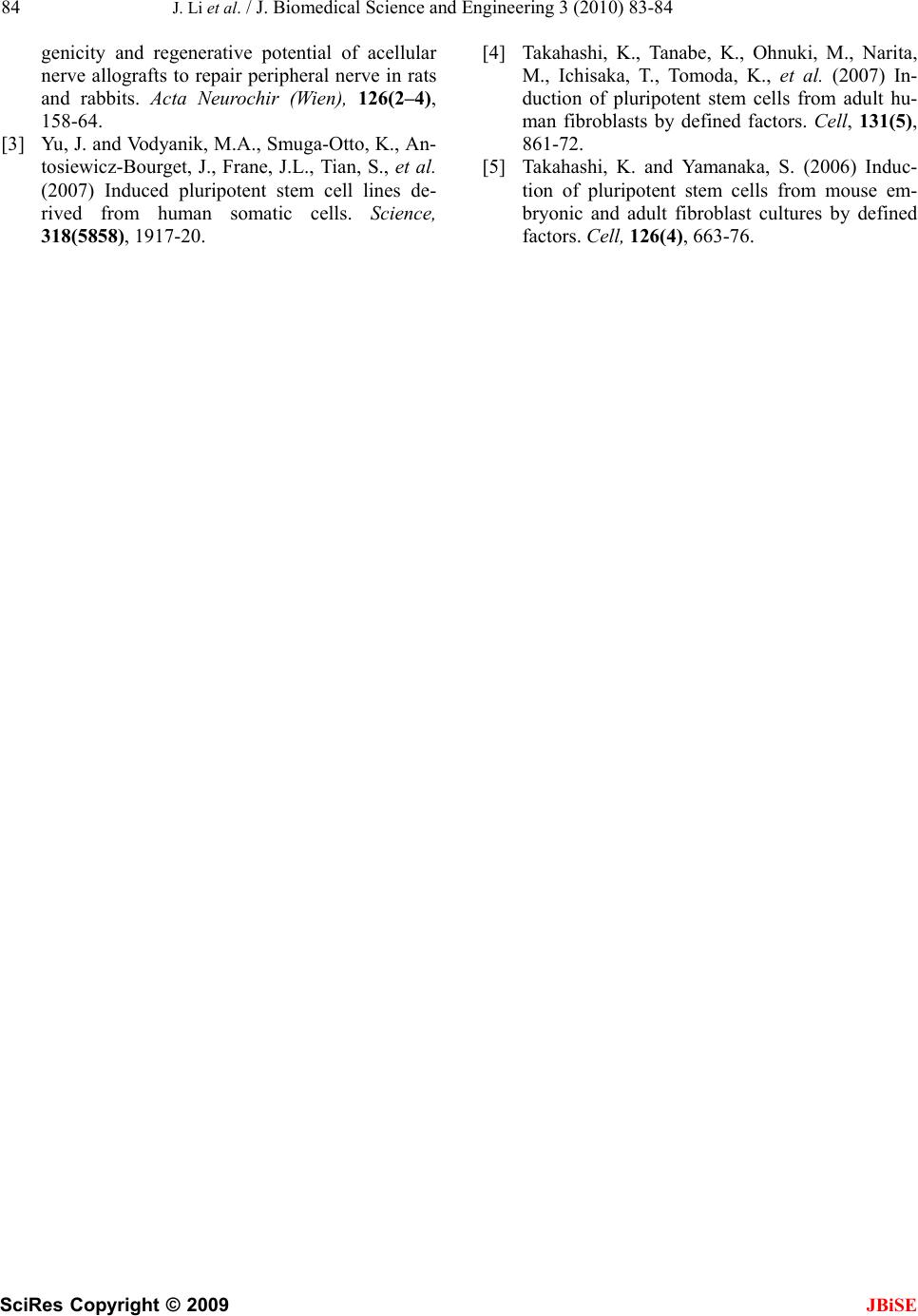Paper Menu >>
Journal Menu >>
 J. Biomedical Science and Engineering, 2010, 3, 83-84 JBiSE doi:10.4236/jbise.2010.31012 Published Online January 2010 (http://www.SciRP.org/journal/jbise/). Published Online January 2010 in SciRes. http://www.scirp.org/journal/jbise Induced-pluripotent stem cells seeded acellular peripheral nerve graft as “autologous nerve graft” Jiang Li1*, Guo-Dong Gao1*, Ti-Fei Yuan* 1Department of Neurosurgery, Tang Du Hospital, The Forth Military Medical University, Xi’an, China. *Email: lijiang19771103@gmail.com; gguodong@fmmu.edu.cn; ytf0707@126.com Received 27 October 2009; revised 9 November 2009; accepted 10 November 2009. ABSTRACT The hypothesis is that induced pluripotent stem cells (iPSC) derived Schwann cells and/or macrophages can be transplanted into acellular nerve graft in repairing injured nervous system. The efficiency of iPSC seeded acellular nerve graft may mimic the autologous periph- eral nerve graft. Keywords: Induced-Pluripotent Stem Cells, Peripheral Nerve Graft; Axon Regeneration 1. INTRODUCTION Brain and spinal cord injury conditions are non-reversi- ble and current therapies are quite limited. Biomaterial transplantation, especially when combined with stem cell technology, provides one of the most attractive solu- tions to repair the injured nervous system, for both cen- tral and peripheral. Available biomaterials include natu- ral sourced materials such as nerve, muscle, tendon, vein, fibronectin, collagen as well as fibronectin, and syn- thetic/engineered materials, such as poly-lactic acid, nanofiber scaffold, biodegradable glass and silicon [1]. However, with more than a century’s laboratory and cli- nical trials, peripheral nerve graft is still the “gold stan- dard”, and autologous peripheral nerve graft provided the best axonal regeneration among all these materials. One existing problem in using peripheral nerve graft to repair the injured nerves is that the obtain of an autologous nerve graft lead to loss of sensory innerva- tion in part of the body, while non-autologous nerve graft though is non-invasive, is of immunogen reactivity and could be expelled. The immunogenic problem could be solved with prior treatment with chemical, thermal, or liquid nitrogen freezing procedures to make the periph- eral nerve graft be acellular. However the acellular grafts lost Schwann cells inside and the extracellular matrix suffers from somewhat disruption. Additionally, the ace- llular graft is not totally free of immunogenic activity due to the existence of non-degraded proteins [2]. 2. THE HYPOTHESIS We propose that the recent developed induced pluripo- tent stem cell (iPSC) technology combined with acellu- lar nerve graft transplantation can provide a novel ap- proach to repair the injured nervous system. The iPSC- seeded acellular nerve graft from other individuals can be functional similar to the autologous nerve grafts. The induced pluripotent stem cells, genetically repro- grammed form any somatic cells can be theoretically promoted into any kinds of cells [3,4,5], including Sch- wann cells and macrophages. We propose that the iPSC could be generated from somatic cells of the patients, and induced into Schwann cells and macrophages before co-transplantation into the acellular allografts or even xenografts. The Schwann cell in the graft has long been found to be neuroprotective and enhancing the axonal remyelination; while macrophage can efficiently remove the remnant proteins and could be helpful in recon- structing the fine structures of extracellular matrix. Dur- ing the induction of pluripotency, some further genetic modifications could be included, such as the expression of trophic factors to enhance the nerve regrowth. 3. TESTING THE HYPOTHESIS It is necessary to induce iPSCs into Schwann cells and macrophages. Then the induced cells can be seeded into acellular nerve graft, potentially autologous at first, to examine their efficiency in mimicking natural and autologous Schwann cells when myelinate the regener- ated nerves. With these experiences, allografts and xeno- grafts could be tested. Finally this may bring a new ave- nue in clinical nerve repair procedures with ethical regu- lations if any are met. REFERENCES [1] Schmidt, C.E. and Leach, J.B. (2003) Neural tissue engineering: strategies for repair and re- generation. Annu Rev Biomed Eng., 5, 293-347. [2] Gulati, A.K. and Cole, G.P. (1994) Immuno-  84 J. Li et al. / J. Biomedical Science and Engineering 3 (2010) 83-84 SciRes Copyright © 2009 JBiSE genicity and regenerative potential of acellular nerve allografts to repair peripheral nerve in rats and rabbits. Acta Neurochir (Wien), 126(2–4), 158-64. [3] Yu, J. and Vodyanik, M.A., Smuga-Otto, K., An- tosiewicz-Bourget, J., Frane, J.L., Tian, S., et al. (2007) Induced pluripotent stem cell lines de- rived from human somatic cells. Science, 318(5858), 1917-20. [4] Takahashi, K., Tanabe, K., Ohnuki, M., Narita, M., Ichisaka, T., Tomoda, K., et al. (2007) In- duction of pluripotent stem cells from adult hu- man fibroblasts by defined factors. Cell, 131(5), 861-72. [5] Takahashi, K. and Yamanaka, S. (2006) Induc- tion of pluripotent stem cells from mouse em- bryonic and adult fibroblast cultures by defined factors. Cell, 126(4), 663-76. |

